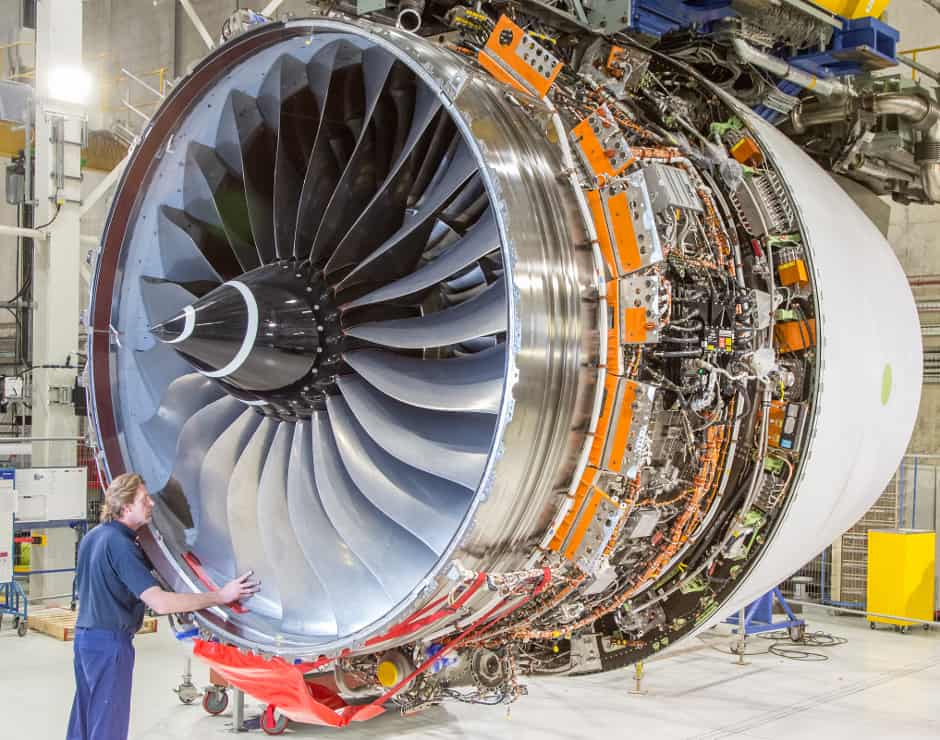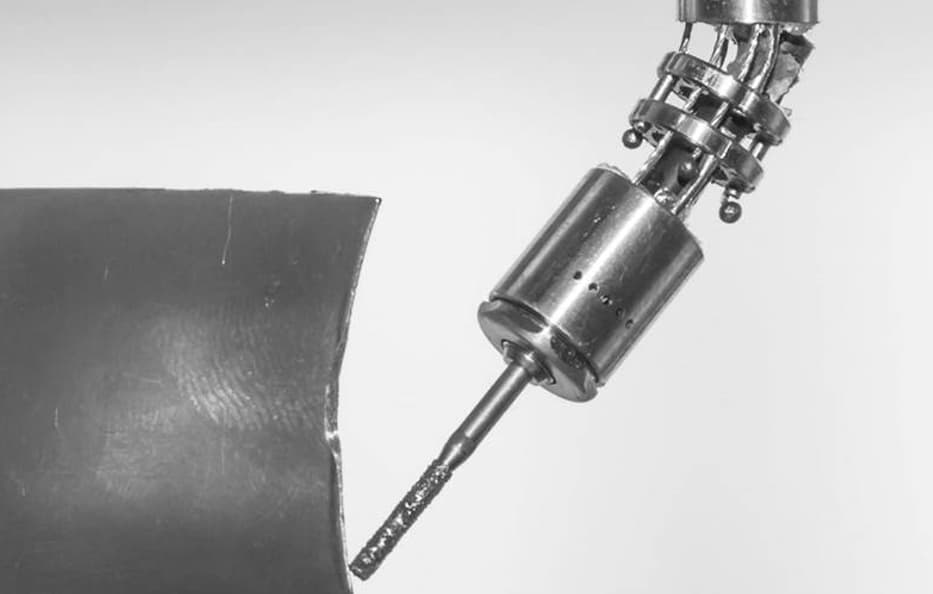Collaborate to Innovate 2018
Category: Defence, Security & Aerospace
Winner: Keyhole surgery for jet engines
Partners: Rolls-Royce plc, University of Nottingham
Rolls-Royce holds the unique position of being only one of a small handful of companies globally that can produce turbofan engines for the world’s civil airlines.
The company currently has 4,567 units in its large jet engine in-service fleet and delivered 259 large engines in H1 2018. In the same period, services to large engines accounted for $1.3bn, a year-on-year increase of 25 per cent.
This substantial slice of revenue is the result of the company’s long-term service agreements which, for most jet engine contracts, puts Rolls-Royce in charge of covering the cost of maintenance, overhaul and repair of customers’ engines and the fleet is getting bigger.
With Airbus alone, the Trent XWB-97 has entered service on the A350-1000; and the Trent 7000 – the engine that will power Airbus’ A330neo - received European Aviation Safety Agency (EASA) certification in July 2018.

Boeing’s commercial market outlook for 2018-2037 predicts a 3.5 per cent growth for the world’s fleet, amounting to 42,730 deliveries in a market valued at $6.3 trillion.
For a company that generates revenues from services the pressure to keep engines running and aircraft in service will increase, which in turn will require a whole new way of looking at delivering packages such as TotalCare, a ‘power by the hour’ arrangement that pays Rolls-Royce for engines that perform.
To this end, Rolls-Royce has launched a strategy to develop technology that gets inside a jet engine to inspect or repair them without dismantling them, and James Kell, Insitu Technology Specialist, Rolls-Royce, has been tasked with taking it forward as an element of the company’s IntelligentEngine vision.
“As part of that [strategy], one of the key themes we were interested in was remote operation; we’re keen to work smarter rather than harder,” he said. “We’ll have a lot more work ahead of us in the future [as] the fleet is growing and we won’t be flushed with people with the right skills, so that’s what’s really driving the thought process behind getting hold of a different way of working and that’s how we came up with the…remote boreblending concept.”
Jet engines are aggressive environments in which compressor blades can incur edge damage due to large volumes of air flow. These anomalies must be rectified by removing and replacing the engine, or repairing the blade in-situ with a boreblending probe that grinds the damaged blade back into shape. The process, which involves inserting boroscopic tooling into the engine via a small inspection port, is highly-skilled and mechanics are required to execute a set number of repairs per year to retain their operating licence.
Nottingham understand the intricate problems we face
“There aren’t a huge amount of people in the company that are able to do such a thing, and guaranteeing they’re in the right place to be able to act quickly around the world is not necessarily an easy task to manage,” Kell said. “Couple with that, if you have an issue that’s uncovered that could potentially impact the whole fleet, trying to address the whole fleet with a small army of people is not necessarily the best way to do that. A strategic network of deployed robots could be a better way of working.”
The remote boreblending solution would see a number of 'slave' robots stationed at strategic global locations, and a 'master' station would allow the skilled mechanic to teleoperate the slave robot after it was installed on the jet engine by any available airline mechanic.
“Your specialists can work on an engine in Sau Paulo, then switch to an engine in Singapore in one day,” said Kell.
With downtime penalties adding up to six-figure sums per day, the impact guideline for the project, said Kell, was to remove the impact time from weeks to days to hours. The idea was proposed to the ATI (Aerospace Technology Institute) via Innovate UK and the University of Nottingham and was developed between January 2014 and March 2017.
Directed by Prof Dragos Axinte, The University Technology Centre for Manufacturing and On-Wing Technologies at Nottingham focuses on the design, development and prototyping of custom solutions for Rolls-Royce in-field maintenance devices.

“The reason we work with Nottingham is because they have a set of skills built up over many years where they understand the intricate problems that we face, like trying to get inside the engine,” said Kell. “It’s easy to say ‘it’s dark in there, its restricted access’ etcetera but the reality is you can’t buy a robot off the shelf to go and do this type of stuff, so they have a lot of skill in designing and manufacturing that kind of hardware to do those types of tasks. Not only that, designing and implementing software makes it controllable as well. So, it’s the hardware and the software: a full custom robotics design and prototype team.”
According to Kell, the team looked at the forces and degrees of freedom required to replicate the existing process, which resulted in the use of a pneumatic motor instead of the belt drive system used in existing boreblend probes.
To make use of the smallest commercially available pneumatic turbine motor, a custom thin wall housing was developed to mount and to guide incoming airflow over the turbine. This was key to the manufacture of a robot probe small enough to pass through inspection ports. A novel acoustic method was then employed to monitor the blade grinding process, which was crucial in understanding the material removal process and for allowing accurate modelling of tool path data and subsequent kinematics.
Furthermore, novel flexible joints with a hollow channel were developed that allow flexible pneumatic hose access to the turbine tool. The joint design was based on continuum or snake-like robots with flexible backbones, a combination of rotating, prismatic and flexible joints.
To communicate and control the robot from a remote location, the team worked with Winnipeg-based Librestream to modify their software to allow for data packet transfer, as well as communication and telepresence. The team realised the concept of obtaining a measurement, generating a tool path from the defect, and sending the tool path as a complete set of directions to the remote robot. This novel approach overcomes the latency issue observed in conventional slave/master systems.
“Librestream were key in helping us define our remote operation protocol, or communications architecture,” said Kell. “From a remote-control point of view, we couldn’t do this project without them.”
Regular interaction between Rolls-Royce and Nottingham allowed for an efficient transfer of information between the teams and helped the project maintain its focus and pass milestones leading to an engine demonstration, which Kell described as ‘everything coming together to do a real-time, remote repair on one of our ex-flight test engines.’
“There are probably two other key milestones,” said Kell. “One being a demonstration of how the process could be automated. That came at the end of year two. At the end of year one, there was a demonstration of the communications protocol which was done using an off-the-shelf toy robot. We controlled it over 3G in Nottingham from a Rolls-Royce office in Derby. We did that also with a secure audio and video line.”
The platform is currently at technology readiness level (TRL) 5 and Rolls-Royce is working with Newcastle-based Tharsus to develop a ‘minimum viable product’
“I’m quite excited about that because …the whole idea of bolting something onto the engine and driving a probe into a gas stream could well be a fundamental building block for deploying a range of other services remotely,” Kell concluded.
The runners up
Kromek – D3S - Kromek with Defence Advanced Research Projects Agency (DARPA), Invincea (now called Two Six Labs) PSI (Physical Sciences Inc)
A collaborative effort on the development of hand-held radiation detectors.
Compressor Aerofoil Residual Stress Mapping – Rolls-Royce with Strathclyde University - Advanced Forming Research Centre
Developing a process for mapping residual stress patterns in compressor aerofoil components.
Delta f - Worcester Scientific with Coomber Electronics and Precision Atomics
Exploring the use of bioMems (biologically inspired microelectromechanical systems) to develop next-generation biological and chemical sensors.




Poll: Should the UK’s railways be renationalised?
I think that a network inclusive of the vehicles on it would make sense. However it remains to be seen if there is any plan for it to be for the...